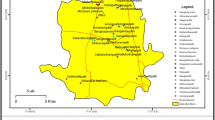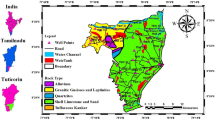Abstract
Groundwater is the main source for agricultural and domestic purposes in the Western Desert of Egypt. Groundwater quality is significantly influenced by the surrounding anthropogenic activities. This paper is one of the attempts to spatially assess groundwater quality and its suitability for drinking and irrigation in Dakhla Oases using Water Quality Index (WQI) and GIS techniques. Calibrated Landsat 8 OLI satellite images were processed to produce Land Use Cover map (LULC) to assess the agricultural and human activities in the study area. Further, eight groundwater quality parameters and WQI were attributed to a GIS layer for 71 investigated wells for mapping purposes using the Inverse Distance Weighting (IDW) method in ArcGIS. LULC map showed that 75% of the study area is a bare land and 25% is urban and agricultural areas. Almost all the studied wells recorded total dissolved solids and sulfate coinciding with the Egyptian permissible limits for drinking purposes. Fe and Mn levels exceeded the allowable limits for drinking in the majority of Dakhla wells. Based on the WQI, 38% and 36.6% of the study area fell within the poor water category according to the Egyptian and WHO standards, respectively. Most of the groundwater wells were of the best quality for irrigation with regard to salinity (less than 2000 mg/L) and the excellent quality in terms of sodium absorption ratio (< 10). It can be concluded that GIS analyses of groundwater quality and suitability can provide one of the necessary inputs for management and planning of Dakhla Oases and other similar regions.










Similar content being viewed by others
References
Abu Al Izz MS (1971) Landform of Egypt. American Univ. Press, Cairo
Ahn H, Chon H (1999) Assessment of groundwater contamination using geographic information systems. Environ Geochem Health 21:273–289
Akkaraboyina MK, Raju BSN (2012) Assessment of water quality index of River Godavari at Rajah- mundry. Univers J Environ Res Technol 2(3):161–167
Appelo CAJ, Postma D (2004) Geochemistry, groundwater and pollution. CRC Press, Boca Raton
Ayers RS, Westcot DW (1985) Water quality for agriculture. FAO Irrigation and Drainage. Paper 29 Rev. 1. Food Agricultural Organisation, Rome
Babiker IS, Mohamed MAA, Hiyama T (2007) Assessing groundwater quality using GIS. Water Resour Manag 21:699–715
Ball J (1927) Problems of the Libyan. Desert Geogr J 70:21–38 (105–128, 209–224)
Bear J (1979) Hydraulics of groundwater. McGraw-Hill International Book, New York
Brown RM, Mccleiland NJ, Deiniger RA, O’ Connor MFA (1972) Water quality index – crossing the physical barrier. In: Jenkis SH (ed) International conference on water pollution research, Jerusalem, vol 6, pp 787–797
Canadian Council of Ministers of the Environment (CCME) (2001) Canadian water quality guidelines for the protection of aquatic life: CCME water quality index 1.0, User’s Manual. In: Canadian environmental quality guidelines, 1999, Canadian Council of Ministers of the Environment, Winnipeg
Carpenter SR, Caraco NF, Correll DL, Howarth RW, Sharpley AN, Smith VH (1998) Nonpoint pollution of surface waters with phosphorous and nitrogen. Ecol Appl 8(3):559–568
Chandra S, Asadi SS, Raju MVS (2017) Estimation of water quality index by weighted arithmetic water quality index method: a model study. Int J Civ Eng Technol (IJCIET) 8(4):1215–1222
Chauhan A, Pawar M, Kumar D, Kumar VN (2010) Assessment of noise sound level status in different areas of Moradabad city. Rep Opin 2(5):59–61
Cude CG (2001) Oregon water quality index: a tool for evaluating water quality management effectiveness. J Am Water Resour Assoc 37(1):125–137
Ducci D (1999) GIS techniques for mapping groundwater contamination risk. Nat Hazards 20(2–3):279–294
Dunnette DA (1979) A geographically variable water quality index used in Oregon. J Water Pollut Control Fed 51(1):53–61
ECOP (2005) Egyptian code for design criteria and construction specifications of drinking water and sanitation purification and pumping stations plants (Potable Water). Minist Hous Util Urban Commun 3:29–30
Edmunds W, Ma J, Aeschbach-Hertig W, Kipfer R, Darbyshire D (2006) Groundwater recharge history and hydrogeochemical evolution in the Minqin Basin. North West China Appl Geochem 21(12):2148–2170
Elbeih SF, El-Zeiny AM (2018) Qualitative assessment of groundwater quality based on land use spectral retrieved indices: case study Sohag governorate. Egypt Remote Sens Appl 10:82–92
Engel BA, Navulur KCS (1999) The role of geographical information systems in groundwater engineering. In: Delleur JW (ed) The handbook of groundwater engineering, chap 21. CRC Press LLC, Boca Raton, USA, pp 1–16
Fahim, FA, Mousa SA, Abdel Aleem MK (1995) Studies on the ground water at an agricultural area, Nile Delta, Egypt. In: Proc. 1st international conference on the environment and development in Africa. Vol. 1. Assiut, Egypt, Assiut University Center for Environmental Studies, 215
FAO (1980) Irrigation and drainage rehabilitation of the mechanized farm. Report by Sir. M. MacDonald & Partners. Project FAO/UNDP/EGY/77/007, pp 7–12
Fianko JR, Nartey VK, Donkor A (2010) The Hydrochemistry of groundwater in rural communities within the Tema Disrict, Ghana. Environ Monit Assess 168:441–449
Franzen WD, Peck TR (1995) Field soil sampling density for variable rate fertilization. J Prod Agric 8:568–574
Gad MI, El Sheikh AE, El Osta MM (2011) Optimal management for groundwater of Nubian aquifer in El Dakhla depression, Western Desert. Egypt Int J Water Resources Environ Eng 3(14):393–409
Gameh MA, Ebtehag AS, El-Habaak GH, Abdel-Moneim MM (2014) Groundwater potentiality and suitability for drinking and irrigation in the New Valley, Western desert. Egypt Assiut J Agric Sci 45(2):113–124
Guendouz A, Moulla A, Edmunds W, Zouari K, Shand P, Mamou A (2003) Hydrogeochemical and isotopic evolution of water in the complexe terminal aquifer in the Algerian Sahara. Hydrogeol J 11:483–495
Gunnink JL, Burrough PA (1996) Interactive spatial analysis of soil attribute patterns using exploratory data analysis (EDA) and GIS. In: Masser I, Salge F (eds) Spatial analytical perspectives on GIS. Taylor & Francis, New York
Jain CK, Bandyopadhyay A, Bhadra AA (2009) Assessment of groundwater quality for drinking purpose, District Nainital Uttarakhand. India Environ Monit Assess 166(1–4):663–676
Kato H, Elbeih S, Iwasaki E, Sefelnasr A, Shalaby A, Zaghloul E (2014) The relationship between groundwater, landuse, and demography in Dakhla Oasis. Egypt J Asian Netw GIS Based Historical Stud 2:3–10
Krishna Kumar S, Chandrasekar N, Seralathan P, PrinceS Godson, Magesh NS (2012) Hydrogeochemical study of shallow carbonate aquifers, Rameshwaram Island. India Environ Monit Assess 184(7):4127–4138
Kurdi M, Tabasi S, Eslamkish T, Hezarkhani A (2013) Hydrogeochemical study to evaluate the suitability of water for irrigation purpose at Qareh sou catchment, North of Iran. Elixir Geosci 62:17536–17541
Leenaers H, Okx JP, Burrough PA (1990) Comparison of spatial prediction methods for mapping floodplain soil pollution. CATENA 17:535–550
Levallois P, Thériault M, Rouffignat J, Tessier S, Landry R, Ayotte P, Girard M, Gingras S, Guavin D, Chiasson C (1998) Groundwater contamination by nitrates associated with intensive potato culture in Que´bec. Sci Total Environ 217:91–101
Magesh NS, Chandrasekar N (2013) Evaluation of spatial variations in groundwater quality by WQI and GIS technique: a case study of Virudunagar District, Tamil Nadu. India Arab J Geosci 6(6):1883–1898
Miller W, Joung HM, Mahannah CN, Garrett JR (1986) Identification of water quality differences Nevada through index application. J Environ Qual 15(3):265–272
Najah A, Eishafie A, Karim OA, Jaffar O (2009) Prediction of Johor river water quality parameters using artificial neural networks. Europ J Sci Res 28(3):422–435
Narany TS, Aris AZ, Sefie A, Keesstra S (2017) Detecting and predicting the impact of land use changes on groundwater quality, a case study in Northern Kelantan, Malaysia. Sci Total Environ 599–600:844–853
Negm AM, Armanuos AM (2016) GIS-based spatial distribution of groundwater quality in the Western Nile Delta, Egypt. In: Negm A (ed) The Nile Delta. The handbook of environmental chemistry, vol 55. Springer, Cham, pp 89–119
Nickson RT, McArthur JM, Shrestha B, Kyaw-Nyint TO, Lowrt D (2005) Arsenic and other drinking water quality issues, Muzaffargarh District, Pakistan. Appl Geochem 20:55–68
Poonam T, Sukalyan C, Sukalyan C (2013) Water quality indices- important tools for water quality assessment: a review. Int J Adv Chem 1(1):15–28
Prasanna MV, Chidambaram S, Srinivasamoorthy K (2010) Statistical analysis of the hydrogeochemical evolution of groundwater in hard and sedimentary aquifers system of Gadilam river basin, South India. J King Saud Univ Sci 22:133–145
Quist LG, Bannerman RR, Owusu S (1988) Groundwater in rural water supply in Ghana. Ground water in rural water supply, report of the West African sub-regional workshop held in accra, Ghana, 20–24 October 1986. UNESCO Technical Documents in Hydrology, Paris, pp 101–126
Ramakrishnaiah CR, Sadashivaiah C, Ranganna G (2009) Assessment of water quality index for groundwater in Tumkur Taluk, Karnataka State. India E-J Chem 6(2):523–530
Rocchini R, Swain LG (1995) The British Columbia water quality index, water quality branch. EP Department, B.C, Ministry of Environment, Land and Park, Victoria, p 13
Salifu M, Yidana SM, Osae S, Armah YS (2013) The influence of the unsaturated zone on the high fluoride contents in groundwater in the Middle Voltaian aquifers—the Gushegu District, Northern Region of Ghana. J Hydrogeol Hydrol Eng. https://doi.org/10.4172/2325-9647.1000107
Sawyer GN, McCarthy DL (1967) Chemistry of sanitary engineers, 2nd edn. Mc Graw Hill, New York, p 518
Schiavo MA, Havser S, Gusimano G, Gatto L (2006) Geochemical characterization of groundwater and submarine discharge in the south-eastern Sicily. Cont Shelf Res 26(7):826–834
US Salinity Lab Staff (1954) Diagnosis and improvement of saline and alkali soils. Handbook No. 60, USDA, Agricultural Research Service. https://www.ars.usda.gov/pacific-west-area/riverside-ca/us-salinity-laboratory/docs/handbook-no-60/page-3/. Accessed 31 Aug 2016
Subramani T, Elango L, Damodarasamy SR (2005) Groundwater quality and its suitability for drinking and agricultural use in Chithar River Basin, Tamil Nadu. India Environ Geol 47(8):1099–1110
Tiwari TN, Mishra MA (1985) A preliminary assignment of water quality index of major Indian rivers. Indian J Environ Prot 5(4):276–279
Vinten AJA, Dunn SM (2001) Assessing the effects of land use on temporal change in well water quality in a designated nitrate vulnerable zone. Sci Total Environ 265:253–268
Walton WC (1970) Groundwater resources evaluation. Mc Graw Hill Book Co, New York
Weber D, Englund E (1992) Evaluation and comparison of spatial interpolators. Math Geol 24:381–391
Weisz R, Fleischer S, Smilowitz Z (1995) Map generation in high-value horticultural integrated pest management: appropriate interpolation methods for site-specific pest management of Colorado potato beetle (Coleoptera: Chrysomelidae). J Econ Entomol 88:1650–1657
WHO (2006) A compendium of drinking water quality standards in the eastern mediterranean region. World Health Organization. Regional Office for the Eastern Mediterranean, Cairo, Egypt, pp 26–44
WHO (2011) Guidelines for drinking-water quality world health organization, 4th edn, Geneva, Switzerland, pp 219–443
Wilcox LV (1955) Classification and use of irrigation waters, U.S.A. Salinity lab. Circulation. No. 969
Yidana SM, Yidana A (2009) Assessing water quality using water quality index and multivariate analysis. Environ Earth Sci 59:1461–1473
Zuane JD (1990) Drinking water quality. Standards and controls. Van Nostrand Reinhold, New York
Acknowledgments
The authors express their thanks to the United States Geological Survey for supporting the Landsat images. Thanks are also extended to the central laboratory of groundwater of the South Western Desert of Egypt for providing the groundwater sampling analysis through the contract project between National Authority for Remote Sensing and Space Sciences, Cairo, Egypt (NARSS) and the New valley Governorate-Western Desert of Egypt.
Author information
Authors and Affiliations
Corresponding author
Ethics declarations
Conflict of Interest
The authors confirm that there is no conflict of interest.
Rights and permissions
About this article
Cite this article
El-Zeiny, A.M., Elbeih, S.F. GIS-Based Evaluation of Groundwater Quality and Suitability in Dakhla Oases, Egypt. Earth Syst Environ 3, 507–523 (2019). https://doi.org/10.1007/s41748-019-00112-1
Received:
Accepted:
Published:
Issue Date:
DOI: https://doi.org/10.1007/s41748-019-00112-1




